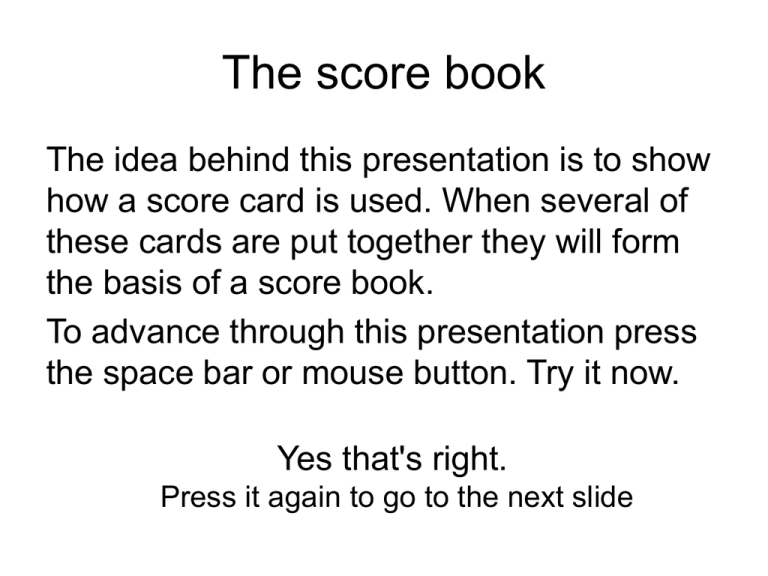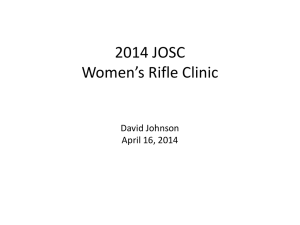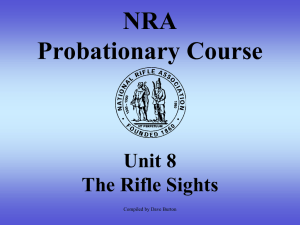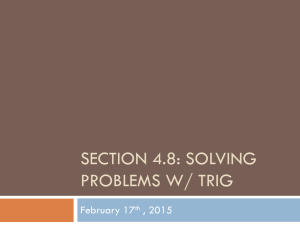Use of Scorecards - Cawdor Rifle and Gun Club
advertisement

The score book The idea behind this presentation is to show how a score card is used. When several of these cards are put together they will form the basis of a score book. To advance through this presentation press the space bar or mouse button. Try it now. Yes that's right. Press it again to go to the next slide The Score book Bullet holes plotted here Record changes of elevation and wind here Plot elevation here Wind chart Plot windage here All changes are in minutes of angle. You need to know how to alter your sight’s aim point in minutes of angle for this presentation to make sense. Elevation and windage recording chart Using the rifle’s zero distance and an elevation table set the sights. Record the elevation setting in minutes here. If the elevation setting is changed the new number is recorded next to the shot number. Shot Wind Elev Left A 3 Call 2 B 1 2 3 The Call column is used to write down the score the shooter thinks he/she got before the target is marked. If the shots are called accurately the shooter can be confident that it is external changes that are causing the bullets to drift throughout a match and adjust. Adjustments are only made on bullets that the shooter is confident in. 4 5 2½ 1½ 6 7 Score Right B B The shooter looks at the wind flags and uses the wind flag chart to read off the windage in minutes of angle. If the wind is blowing from the left to the right the bullet will be moved to the right. The sights will have to be moved left to correct this. Corrections to the left are put in the left hand column. If the wind is blowing from the right to the left the bullet will be moved to the left. The sights will have to be moved right to correct this. Corrections to the right are put in the right hand column . The corrections are then put on the sights. 8 The windage is recorded here. The centre circle is used to show direction of the wind. Changes in the windage setting are recorded next to the shot number. 9 10 11 12 To fill in the column put one of the following letters in the box in the same row as the shot: B = Bull I = Inner M = Magpie O = Outer The score column is used to write the actual score in (as indicated by the spotting disk etc). It should be very close if not the same as the call score. 13 14 15 Score How to work out the true elevation and adjust the sights accordingly Looking at the row of circles between the target and the elevation grid on the far right hand side, the number that has been worked out from looking at an elevation table and the rifles zero is put in line with the centre of the target. I.e. my rifle is zeroed at 300 yards and from the table I will need to come up 7 minutes of angle. Next the rest of the circles are numbered. In the first column a dash is put against the number that equates to the setting on your rifle sight. The first round is then fired and the hole is plotted on the target. It is then plotted on the elevation grid by counting the minutes of angle above or below the centre line and then going the same amount above or below the dash. L 4 3 2 1 0 1 2 3 4 R A 4 3 3 4 2 5 B 1 2 3 4 5 6 7 8 9 1 x x x xxxx x 6 xx x 0 7 1 8 2 9 3 10 4 11 10 11 12 13 14 15 The next few shots are fired and plotted in the same way until a pattern can be seen. It can be seen that on average the bullets are going 1 ½ minutes high. If the mean point of impact is taken and an imaginary line is drawn horizontally to the numbers down the side it can be seen that the sights should be set at 5 ½ minutes of angle. The dash is now moved to the new elevation setting and subsequent shots fired. These should now fall on the zero line. In an ideal world the cross should be on top of the dash. If they start to drift then further adjustments will be necessary. How to work out the true elevation and adjust the sights accordingly - cont To recap on the last page, here is a further example. Sights are set to 5 minutes of angle above the rifle’s zero. Bullet holes are approx 1 ½ minutes above the zero line, adjust sights 1 ½ minutes lower to 3 ½ minutes of angle above the rifle’s zero. Bullet holes are again wandering away from the point of aim. Time to re-adjust the sights - this time by moving the sights up by 1¼ minutes of angle to 4 ¾ minutes above the rifle’s zero. This example has exaggerated the amount of sight adjustment. The amount of movement may only be ½ or ¼ of a minute of angle at a time. Depending on confidence of the shooter in his/her ability the sights may be adjusted after only one or two shots. L 4 3 2 1 0 1 2 3 4 R A 4 1 3 2 2 3 B 1 2 3 1 x x x x x 4 0 5 1 6 2 7 4 3 8 4 9 5 6 7 xx x x 8 9 10 11 12 13 14 15 How to work out the true wind and adjust your sights accordingly By using the wind flags and wind speed to minutes of angle tables set the estimation of correction on the rifle sight and the chart. For this example the wind is blowing from the left to the right and L requires 2 minutes of angle left to correct. Next the other numbers on the chart are filled in. Notice that left and right have been transposed and the zero position has been offset to allow more leeway for the wind to pick up or drop. 4 A dash is put underneath the estimate and a round is fired. 2 The bullet hole is plotted on the chart. 4 3 2 1 0 1 2 3 4 R 2 1 0 1 2 3 x x x x x 4 5 6 L 3 1 This process is continued for a couple of shots. 0 It can be seen that the bullets are going approximately 1¼ minutes of angle to the right of the centre line. Probably the wind 1 was stronger than the estimate. 2 By looking at the chart it can be seen that the mean point of impact is reading 3¼ minutes on the chart. This is what is now set 3 on the rifle sight. The dash is moved under the new setting and the windage is plotted for subsequent shots. The chart now indicated the wind has dropped. The sights are re-adjusted to about 2 minutes. 4 R A B 1 2 3 It should be remembered that in an ideal world the cross should be on top of the dash every time. 4 5 6 7 8 9 An experienced shot will adjust on each shot or by looking at the wind flags. The average shooter will adjust on trends. 10 11 12 13 14 15 x x x x x What it looks like all together Estimated elevation 5 minutes up from the rifle’s zero, estimated crosswind 2 minutes blowing from the right to the left. Shot Elev A Wind Call Right Left 5 4 3 2 1 0 1 2 3 4 R A B 1 2 3 4 5 6 7 8 9 10 11 12 13 14 15 2 B 1 L Score 4 1 3 2 2 3 1 4 0 5 1 6 2 7 3 8 4 9 3.5 1 2 3 4 5 6 7 8 9 xxx x x x 10 11 12 13 14 15 Score The score card is now ready for the sighting shots. The holes are about 1½ minutes high and 1 minute left of centre. Now look at the charts and read off the true windage and true elevation. R A B 1 2 3 4 5 6 7 8 9 10 11 12 13 14 15 4 3 2 1 x x x x x x 0 1 2 3 4 L The windage reads approx 1 minute left and the elevation reads approx 3½ minutes up. Record this on the chart on the left and adjust the sights. Note: It is usual to adjust the elevation or windage separately. To sum up To use a score card successfully the shooter needs to practice, practice, practice. Until the shooter can group his/her shots then he/she cannot rely on them to show movement away from the point of aim. The smaller the group the quicker trends will become apparent. When the shooter is ruled out of the equation then other factors can be anticipated and allowed for, thus shot correction becomes proactive instead of reactive. The elevation setting on the rifle can and will need to be changed with variations in ambient temperature, firearm temperature, air pressure, wet rounds, moisture in the air and light conditions. This can happen very quickly, but try to anticipate change rather than follow it. It is important for the shooter to move as little as possible between shots and to keep everything else the same. Stick to a routine as even a small difference can mean an inner instead of a bull at 1000 Yards. Reading the wind is a bit of a black art, eye of newt, ear of bat etc. When shooting on a range with wind flags you will have noticed that flags at the same distance rarely show the same wind speed; this is also true when looking at flags at different distances. Wind conditions can even vary from firing point to firing point. The shooter will use all his/her experience to look at the wind flags, trees, grass, mirage, etc and make his/her best estimate. Shooting teams often have one person appointed as a wind coach for the team. Practice will help, failing that consult your local witches supply store for some different ingredients. I hope this slide show has been helpful. Unfortunately explaining how you fill in a score card is a lot more complex than actually doing it. The best way to learn it is to do it. So grab an experienced shooter and get them to walk you through it. It is also helpful if you can get someone to watch you as you fill it in at a shoot. Good Luck!









